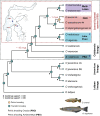Potential Contribution of Ancient Introgression to the Evolution of a Derived Reproductive Strategy in Ricefishes
- PMID: 37493080
- PMCID: PMC10465105
- DOI: 10.1093/gbe/evad138
Potential Contribution of Ancient Introgression to the Evolution of a Derived Reproductive Strategy in Ricefishes
Abstract
Transitions from no parental care to extensive care are costly and involve major changes in life history, behavior, and morphology. Nevertheless, in Sulawesi ricefishes, pelvic brooding evolved from transfer brooding in two distantly related lineages within the genera Adrianichthys and Oryzias, respectively. Females of pelvic brooding species carry their eggs attached to their belly until the fry hatches. Despite their phylogenetic distance, both pelvic brooding lineages share a set of external morphological traits. A recent study found no direct gene flow between pelvic brooding lineages, suggesting independent evolution of the derived reproductive strategy. Convergent evolution can, however, also rely on repeated sorting of preexisting variation of an admixed ancestral population, especially when subjected to similar external selection pressures. We thus used a multispecies coalescent model and D-statistics to identify gene-tree-species-tree incongruencies, to evaluate the evolution of pelvic brooding with respect to interspecific gene flow not only between pelvic brooding lineages but also between pelvic brooding lineages and other Sulawesi ricefish lineages. We found a general network-like evolution in Sulawesi ricefishes, and as previously reported, we detected no gene flow between the pelvic brooding lineages. Instead, we found hybridization between the ancestor of pelvic brooding Oryzias and the common ancestor of the Oryzias species from the Lake Poso area. We further detected signs of introgression within the confidence interval of a quantitative trait locus associated with pelvic brooding in O. eversi. Our results hint toward a contribution of ancient standing genetic variation to the evolution of pelvic brooding in Oryzias.
Keywords: Sulawesi ricefishes; ancient gene flow; convergent evolution; pelvic brooding; reproductive strategy.
© The Author(s) 2023. Published by Oxford University Press on behalf of Society for Molecular Biology and Evolution.
Figures



Similar articles
-
A landmark-free analysis of the pelvic girdle in Sulawesi ricefishes (Adrianichthyidae): How 2D and 3D geometric morphometrics can complement each other in the analysis of a complex structure.Ecol Evol. 2023 Oct 18;13(10):e10613. doi: 10.1002/ece3.10613. eCollection 2023 Oct. Ecol Evol. 2023. PMID: 37859830 Free PMC article.
-
Complex sexually dimorphic traits shape the parallel evolution of a novel reproductive strategy in Sulawesi ricefishes (Adrianichthyidae).BMC Ecol Evol. 2021 Apr 20;21(1):57. doi: 10.1186/s12862-021-01791-z. BMC Ecol Evol. 2021. PMID: 33879056 Free PMC article.
-
The genetic basis of a novel reproductive strategy in Sulawesi ricefishes: How modularity and a low number of loci shape pelvic brooding.Evolution. 2022 May;76(5):1033-1051. doi: 10.1111/evo.14475. Epub 2022 Apr 11. Evolution. 2022. PMID: 35334114
-
Genetic basis for the evolution of pelvic-fin brooding, a new mode of reproduction, in a Sulawesian fish.Mol Ecol. 2022 Jul;31(14):3798-3811. doi: 10.1111/mec.16555. Epub 2022 Jun 10. Mol Ecol. 2022. PMID: 35638236
-
Mesozoic origin and 'out-of-India' radiation of ricefishes (Adrianichthyidae).Biol Lett. 2021 Aug;17(8):20210212. doi: 10.1098/rsbl.2021.0212. Epub 2021 Aug 4. Biol Lett. 2021. PMID: 34343438 Free PMC article. Review.
Cited by
-
A landmark-free analysis of the pelvic girdle in Sulawesi ricefishes (Adrianichthyidae): How 2D and 3D geometric morphometrics can complement each other in the analysis of a complex structure.Ecol Evol. 2023 Oct 18;13(10):e10613. doi: 10.1002/ece3.10613. eCollection 2023 Oct. Ecol Evol. 2023. PMID: 37859830 Free PMC article.
-
Increased phenotypic diversity as a consequence of ecological opportunity in the island radiation of Sulawesi ricefishes (Teleostei: Adrianichthyidae).BMC Ecol Evol. 2025 Mar 12;25(1):19. doi: 10.1186/s12862-025-02355-1. BMC Ecol Evol. 2025. PMID: 40075281 Free PMC article.
References
-
- Arendt J, Reznick D. 2008. Convergence and parallelism reconsidered: what have we learned about the genetics of adaptation? Trends Ecol Evol. 23(1):26–32. - PubMed
-
- Arnold ML. 2007. Evolution through genetic exchange. USA: Oxford University Press.
-
- Bainbridge DRJ. 2014. The evolution of pregnancy. Early Hum Dev. 90(11):741–745. - PubMed
Publication types
MeSH terms
LinkOut - more resources
Full Text Sources

